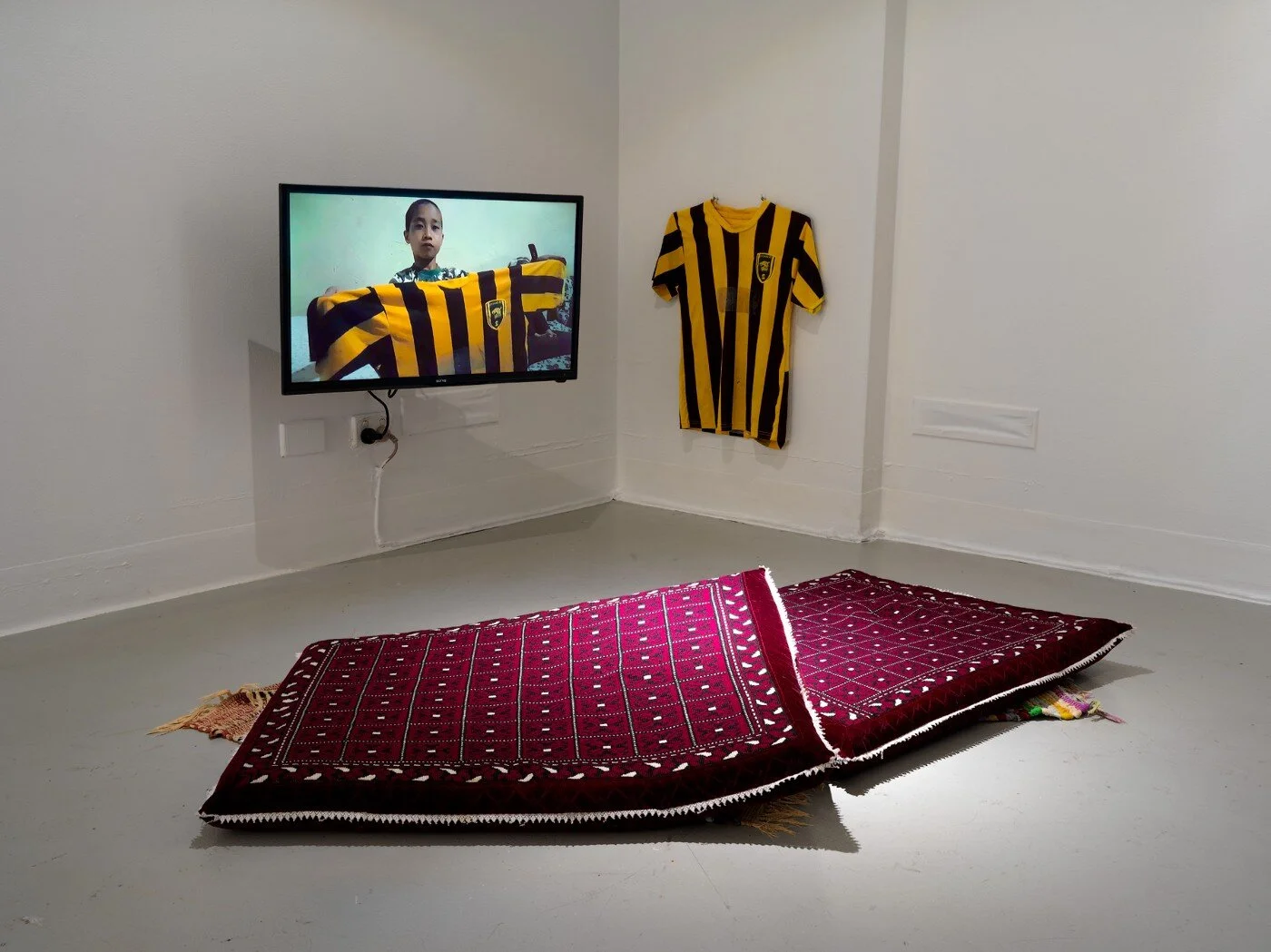Image: Elyas ALAVI, Mohammad Jaan, 2016, T-shirt, video, 5:45 min, installation view, Nexus Gallery, Lion Arts Centre, Tarntanya (Adelaide), 2017. Photo: Grant Hancock
We die so that
by Andrew Dearman
Commissioned by Nexus Arts, 2017
be present
We are often overwhelmed by the mass media’s images of trauma experienced by others elsewhere, to the point where we become cold and disengaged. It’s not so much the images or the way that they are presented that causes us to disengage, it’s the framing — the rhetoric of fear mongering asserted by some sections of the media and the political elite. We are supposed to disengage — to not feel anything.
We are often overwhelmed by the immediacy of the media images that we see. The cold distance of the ‘news cameraman’ has been replaced by the handheld iPhone camera. It speaks more to the idea of the witness — the first-hand account. The mass media make use of this mobile technology and reframe it according to their own agenda, but what happens when the frame is changed again, even removed? What happens when the space in which we view images of distress, and the voices of the other is different? Within a gallery?
An art gallery has a certain amount of baggage that can get in the way — that of commodity and value; the notions of beauty and taste. Not all galleries are like that, however. Exhibition openings are certainly weird social occasions where the works presented fight for our attention. It’s important to return to these works when it’s quiet. To see. To listen.
An art gallery is a space in which we encounter profound experience. This is the space where we share what we have made from what we have seen. This is the space where we see what has been made of something seen/experienced. This is where we come to tell stories, and like a Mosque, Cathedral, Temple a Gallery is also a place where we sometimes come to cry.
to listen
The task of the ‘catalogue essay’ is to help to frame the work for the viewer. It sometimes points to theory or broader concepts out in the world as a ground for the work — to contextualise it. It’s supposed to be profound — the writer risking a level of self-indulgence that can get in the way of the artist’s work. I don’t want to put anything more in the way of you and Elyas than what I’ve briefly written here. When I met Elyas with a view to writing this, I was thinking ‘How can I write anything for this?’ It felt like an impossible task. Ten minutes after I left him, I sat on the steps of a building in King William St, scrawling notes by hand. I wandered the city for two hours writing on door steps in a strange state of distress. My plan had been to transcribe all of my notes here, but I can’t, only a few lines. All my notes point back to one thing: to listen.
“Sometimes it’s important to for us to stop and listen. I’m sitting here on the step of a building in King William St. Traffic sounds, car breaks, engines, humming, the sound of shoes moving past on the pavement right in front of me as I write this — as I watch these words appear on paper. Hand moving past words on the page in front of me as I watch. Listening. Everybody’s going home. I know that I could and walk away from here; and I will in a minute. But for now, I just need to sit. There’s no one near me, but I can hear voices, and I’m trying to not cry. It feels like I’m in the middle of some kind of manic episode, and I’m trying not to cry.
Someone was sitting next to me a moment ago, telling me about what he’d seen, what he’d heard — an experience that left a loud ringing in his ears, pain in his head, fragments from the bomb used in a suicide attack in which perhaps over a hundred people were killed. Some never found. For some of the relatives, the most that they could find of their child to bury was a leg. The day after the bombing, the belongings of the deceased were spread out on a large flag, for relatives to come and identify. Blood soaked pieces of paper. A shattered mobile phone. Discarded shoes.
Me, here safe on a sidewalk, a discarded receipt for Haighs Chocolate on the ground at my feet. I had to stop. Write and listen to what’s around me. A few minutes ago, I sat listening to Elyas Alavi telling me about the experiences behind these current works. His words are slow and gentle. His intention perhaps simply the idea that we should care for those who are lost. That we should listen to their stories, and that we should speak of them.
Two hours of wandering has been like ten minutes — from daylight into the dark. Listening and giving yourself the space in which to cry in response to the stories that you’re told seems the best way to honour those who tell you about what’s happened to them; who tell you about what they’ve seen; who tell you about what they’ve been told by others.”
— Andrew Dearman is an artist and writer in Tarntanya (Adelaide), South Australia.
First published by Nexus Arts, medium.com/@NexusArts/we-die-so-that-912129edd88

